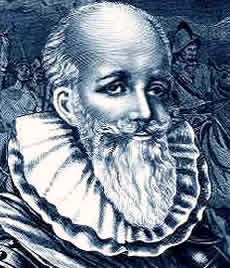 |
| Bernal Díaz del Castillo - Spanish Historian |
Journeying to Panama in 1514 with a military expedition led by Pedrarias Dávila, he then went to Cuba and participated in two initial reconnaissance expeditions of the Mexican gulf coast under Francisco Hernández de Córdoba and Juan de Grijalva. It was his experiences in the subsequent expedition of Hernán Cortés in 1519 that provided him with the raw material from which he penned his classic chronicle many years later.
Lauded especially for its direct and plainspoken style—and criticized for its pedestrian rudeness—Díaz’s True History provides an intimate and unvarnished look at the conquest of Mexico from the perspective of a common foot soldier.
Among the most oft-cited portions of his chronicle are those describing the Spaniards’s first sighting of the Aztec island-city of Tenochtitlán, the entry of Cortés’s army into the basin of Mexico, and the initial meeting between Cortés and Moctezuma II. Also frequently quoted is his remark on the mingling of religious and economic motives that propelled the Spanish conquests in Mexico and beyond.
Intending to honor his fallen comrades, he wrote: “For they died in the service of God and of His Majesty, and to give light to those who sat in darkness—and also to acquire that wealth which most men covet.” This was a remark that the 19th-century historian William Prescott described as “a specimen of that naïveté which gives an irresistible charm to the old chronicler.”
 |
| statue of Bernal Díaz del Castillo |
It was from his encomienda in Guatemala in the late 1500s that Díaz (who was, by his own description, an infirm, deaf, and blind old man) brought to completion his True History, begun years before and finished largely as a rebuttal to other chronicles of the conquest of Mexico that incensed him because he regarded them as filled with inaccuracies.
Contemporary English translations have pruned many redundancies and excised many superfluous passages, trimming the original five volumes down to one and making The Conquest of New Spain one of the most gripping and popular accounts of one of the most consequential episodes in world history.
EmoticonEmoticon